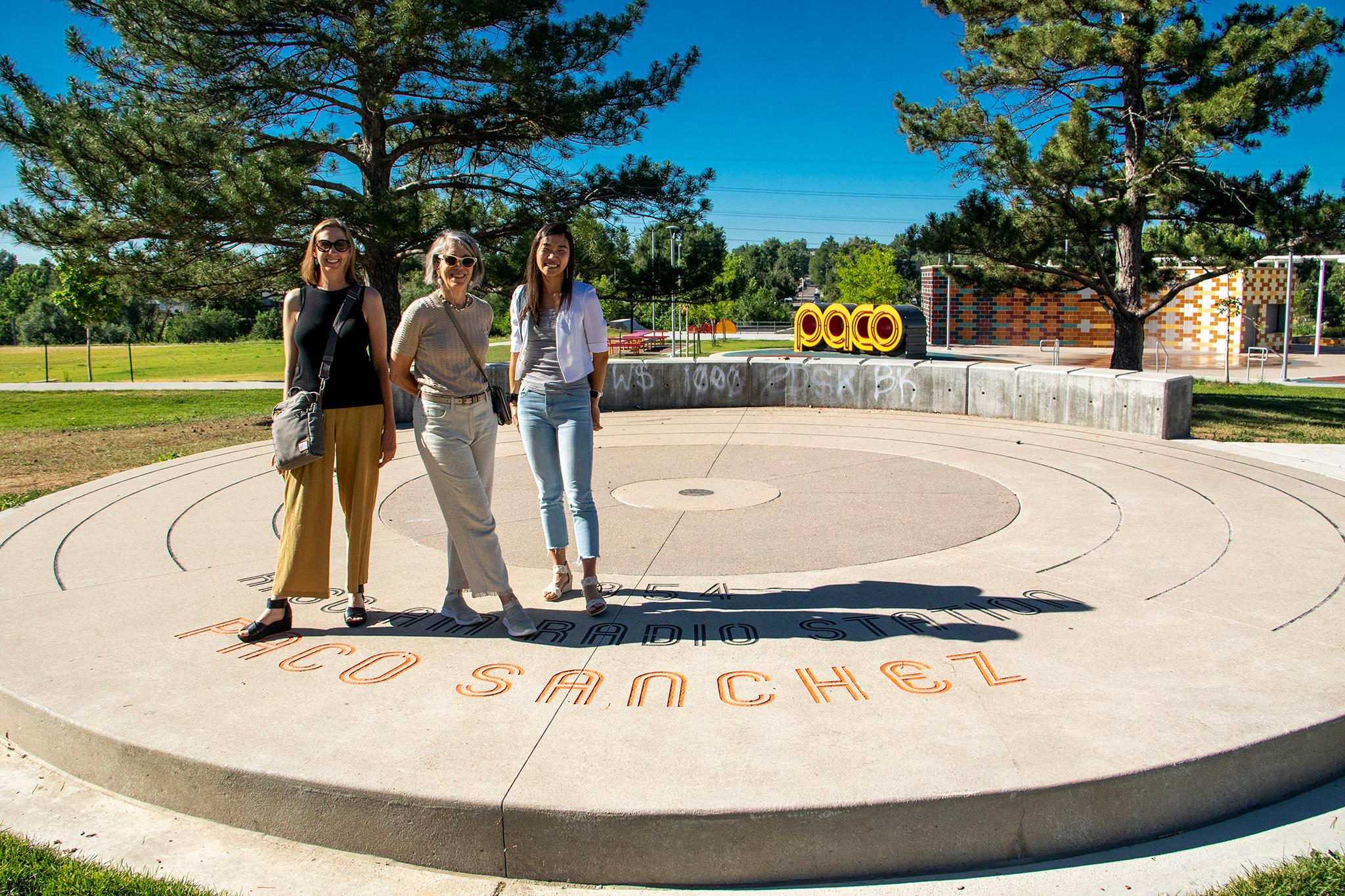Stand in the center of the record-shaped stage at Paco Sanchez Park, look south toward Lakewood Gulch, and sing a song. If you're in the right spot, your soundwaves will vibrate against the stage's concrete lip. Then, they'll bounce back to your eardrums and confuse you.
"Why do I sound like a cyborg?" you might ask. "What is this sci-fi witchery? Did I put the wrong mushrooms in my omelet? Again?"
I stumbled on the effect a few weeks back. When I asked the park's celebrated designers from Dig Studio -- who couldn't be more thoughtful in how they reworked the 1958 park -- whether the effect was intentional, they said no.
But they entertained a visit to the site on Thursday morning to see if I was hallucinating or on to something.
"Okay, here is my theory," I told them, walking toward the magic spot in the middle of the concrete record-shaped stage. "If you stand right here, I don't know if you can hear it...but..."
"I just heard it," said landscape architect Elizabeth Milan.
"Now I just heard you," said Principal Partner Gretchen Wilson to her co-worker. "It echoes."
"Yeah," said Milan.
"Yeah."
"It's like the sound bounces back," said Wilson.
"I'm gonna try it," said Principal Partner Laurel Raines. "Oh yeah!"
"It has to do with this whole bowl-shaped form," explained Wilson. "I think a lot of concrete echoes."
The effect echoes something the designers wanted to install but could not fit within the budget.
"It's really funny," said Milan. "A long time ago, when we were designing all the play programs, we wanted to have this kind of actual feature called a whisper dish that creates this sound play, and you whisper on one end, and then you can hear on the other end very clearly and loudly. But we couldn't do that because of ... the budgets.
"We wanted multi-purpose play on every element, and [the whisper dish] had kind of one purpose," Milan said. "So we had to let go of that idea. But I'm glad that this kind of creates that."
This sonic effect also echoes a similar, now defunct phenomenon on a granite circle at the top of "Stoner Hill" in Commons Park that the landscape architects at Civitas dubbed: "The Sky Garden."
Drunk punks of yore used to climb the hill and marvel at the distortion of their screams at the site.
Unfortunately, the granite wall of the Sky Garden didn't just bounce soundwaves. It became a choice hiding spot for people looking to smoke weed and shoot up, away from the prying eyes of the public.
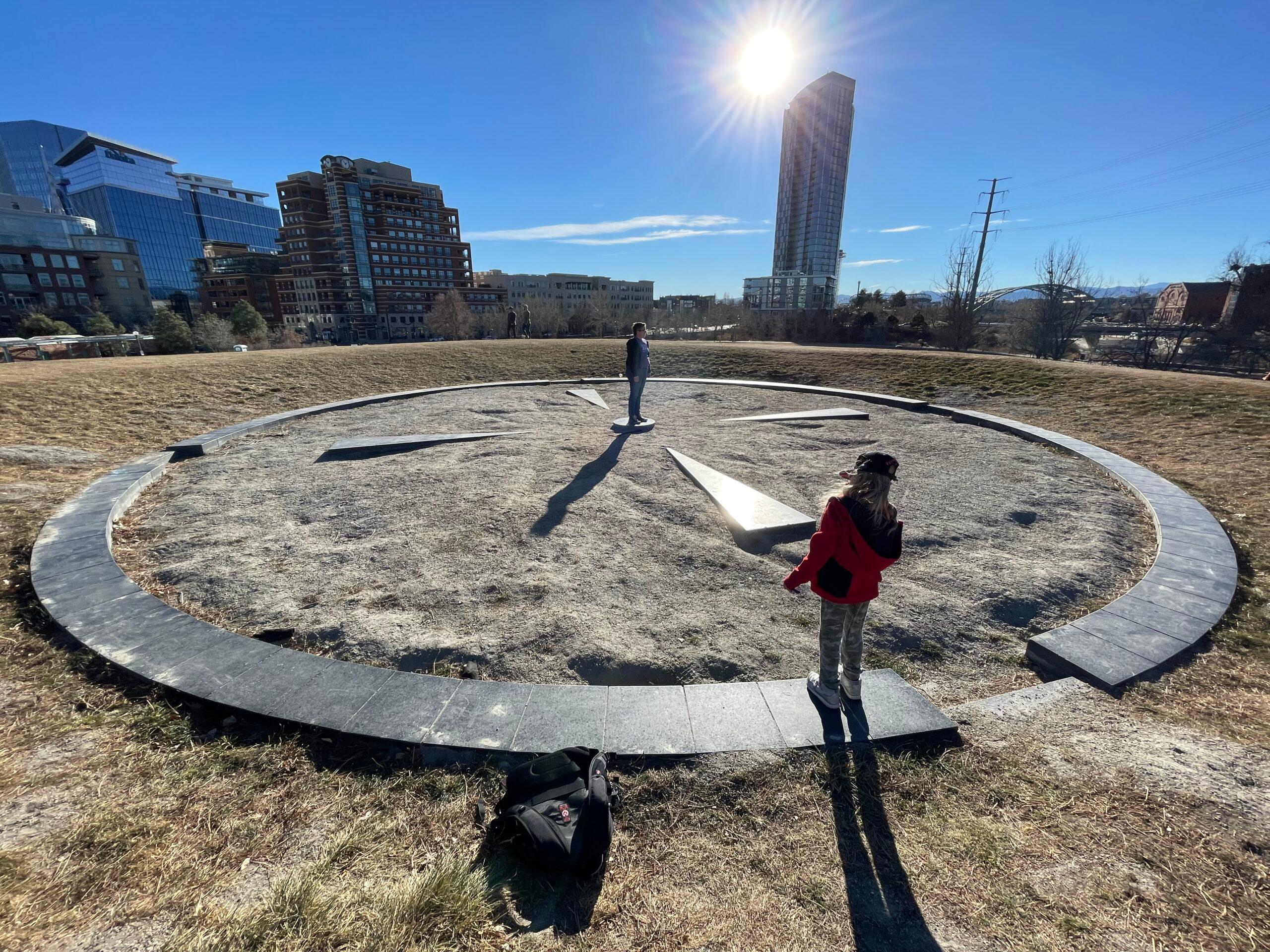
Eventually, Parks and Recreation caught on and reworked the site, filling in the wall and destroying that sound phenomenon -- a part of the original design.
This new phenomenon, at Paco Sanchez Park, wasn't intentional. It's a happy accident -- and a fitting tribute to the park's namesake.
Frederico "Paco" Sanchez, the founder of Denver's first Latino radio station, is remembered by many as a community hero.
Born in Guadalajara, Mexico in 1915, Sanchez started his career in entertainment, music and magic, according to the Western History Archives at the Denver Public Library. He moved to Denver in 1948 to emcee a music show. When he realized there were no Spanish-language radio stations or programs to entertain the 30,000-some Latinos living in the area, he remedied that. He started hosting his own program in 1949, and in 1954, he purchased an AM radio station and began broadcasting from his kitchen.
Over the decades, he advocated against racist banking practices that were icing out Mexican immigrants from homeownership. He even formed a community credit union to help people secure loans to purchase homes. His organization, Good Americans Organization, worked with immigrants to secure their citizenship and also built affordable housing projects.
In 1968, he became a state representative, earning some criticism from the Chicano movement for not championing some of their views. Eventually, his radio station was burned down, and he died in 1973 from surgery complications.
Though he had some detractors, many in the community cherished him. The city named the park after him the year he died.
When it came time to rework the park, his life and love of music inspired the color palette, the structural and architectural elements and the landscaping.
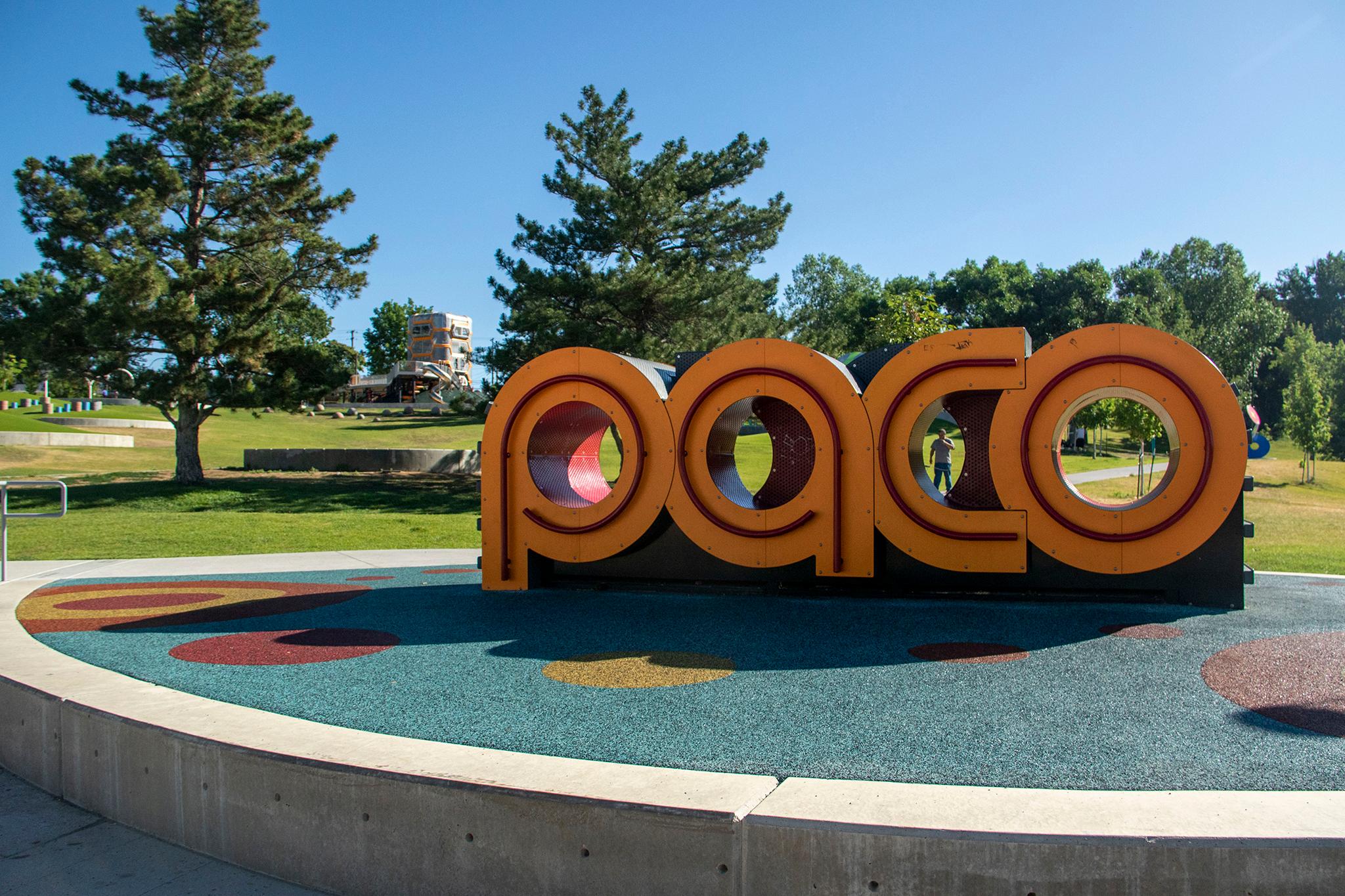
The first iteration of what would become the Paco Sanchez Park design was originally created in 2012 as part of a competition for a doomed project at City Park called the City Park Loop.
Dig Studio's design won second place -- not that it mattered. The City Park Loop was scuttled after neighbors objected to the winning design, argued it did not involve enough community input, and would disrupt the historic character of the neighborhood.
After the fallout, the city tapped Dig Studio to bring its design to another spot.
"So the Parks Department looked everywhere in the city to decide which neighborhood park deserved this the most, or needed it the most," said Raines.
Then City Councilman Paul López called Denver Parks and Rec and said his office wanted it at the Paco Sanchez site, which had been in rough shape for decades.
"The trees were here, the park was here, the pathetic little playground and a totally underused baseball diamond," Raines said. "But no one was here."
At a community meeting, 89-year-old Nettie Moore championed the project, arguing her neighbors' children would love it.
When it came time to vote, "Nettie put up her hand, and 75 hands went up," Denver Parks and Recreation Deputy Director Scott Gilmore told Denverite last year.
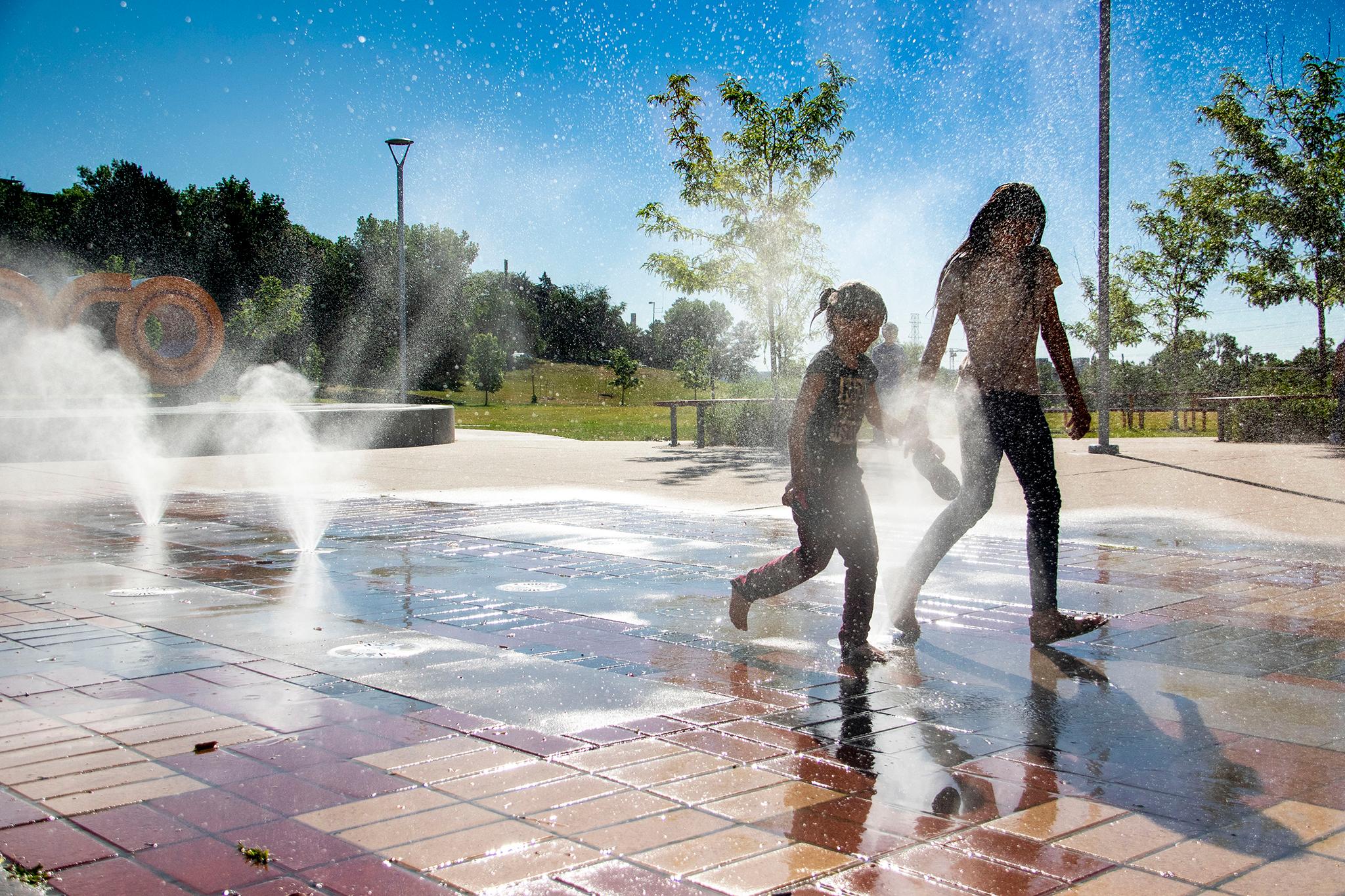
The site was also picked because of the troubling economic conditions of the surrounding West Colfax neighborhood.
"The reason they chose Paco Sanchez Park was because the neighborhood had a very, very high childhood obesity rate, had a very high low-income rate," Raines said. "And there was a real need for investment in this neighborhood. And there hadn't been."
To get funding from the Colorado Health Foundation, Dig Studio studied the site and found that only 3% of the people who came to the park were playing. Raines and her team set out to change that.
"The goal was to get people here playing and moving and being healthy: emotionally, socially and physically," she said.
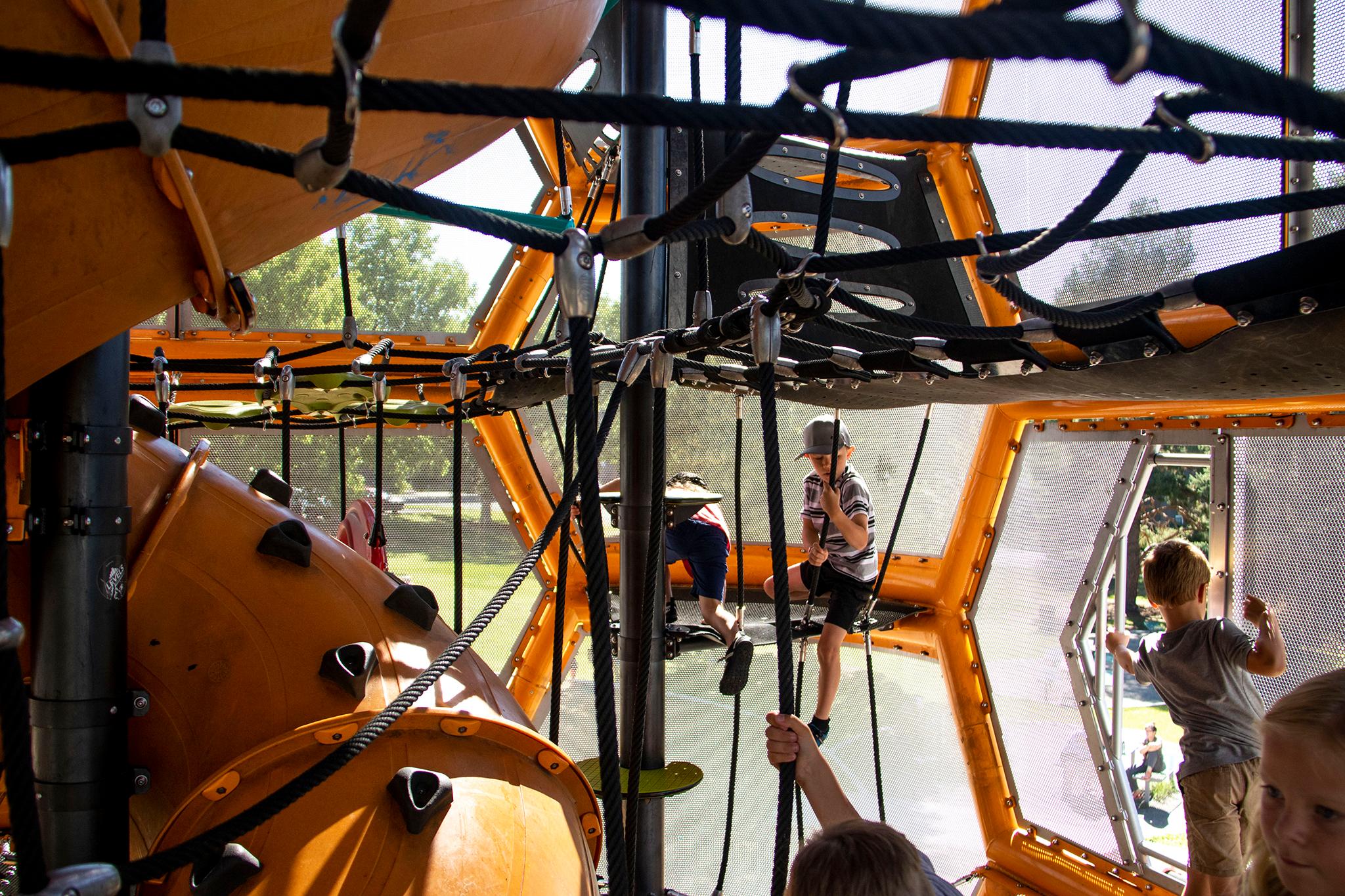
The original loop design, for City Park, was created for a flat site. At Paco Sanchez Park, Dig Studio had the chance to work on a more interesting steep grade.
"The design at City Park was very different than this," Wilson said. "Before, it was just like a blue ring of pipe. And fun things happened along that loop. But when it came to this park, it had to be totally different. And it also needed to reflect the community."
The community wanted a plaza for events, a stage for live music, and even an ice-skating rink, all of which the designers created.
They even worked with Denver artist Carlos Frésquez who installed a sculpture, "Que Viva Paco," funded by the city's 1% for art tax on all public construction projects that cost $1 million or more.
On weekends and afternoons, the park is crammed with families.
Kids climb play structures shaped like sound waves, an old-fashioned microphone, or the twirling dresses of folklórico dancers. Children skip up and down the lawn, pausing to beat drums emblazoned with the names of traditional Mexican instruments. Teens shoot hoops or jump ramps on bikes, scooters and skateboards.
Tots and elders alike cool off in the splash pad. And families take shelter from the sun under the park's original trees, watching the new ones grow. Children leap and scramble over large rocks and traverse concrete beams.
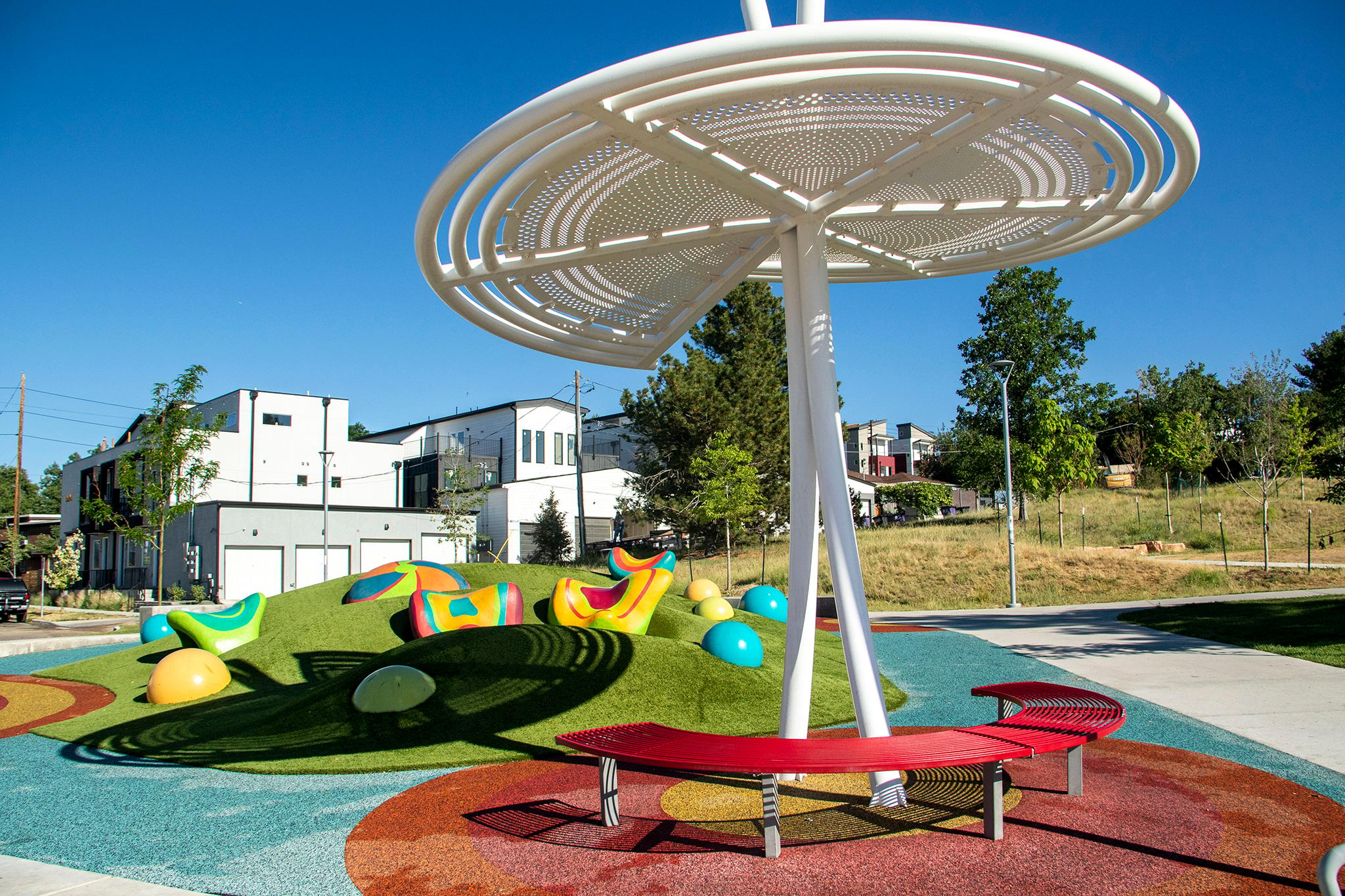
At the top of the hill, there are three ways to enter the park: climbing down the steep part; walking or rolling a gentle, accessible slope; or speeding down a wide, concrete slide that tosses riders into mulch at the bottom.
"There are multiple ways to go up and down," said Milan. "And there's handholds. There's rope. There's hoops to go through. So we wanted to create more reason to go and then enjoy."
On Thursday, children climbed into the massive microphone-shaped tower. While Wilson and Milan waited outside, Raines raced up.
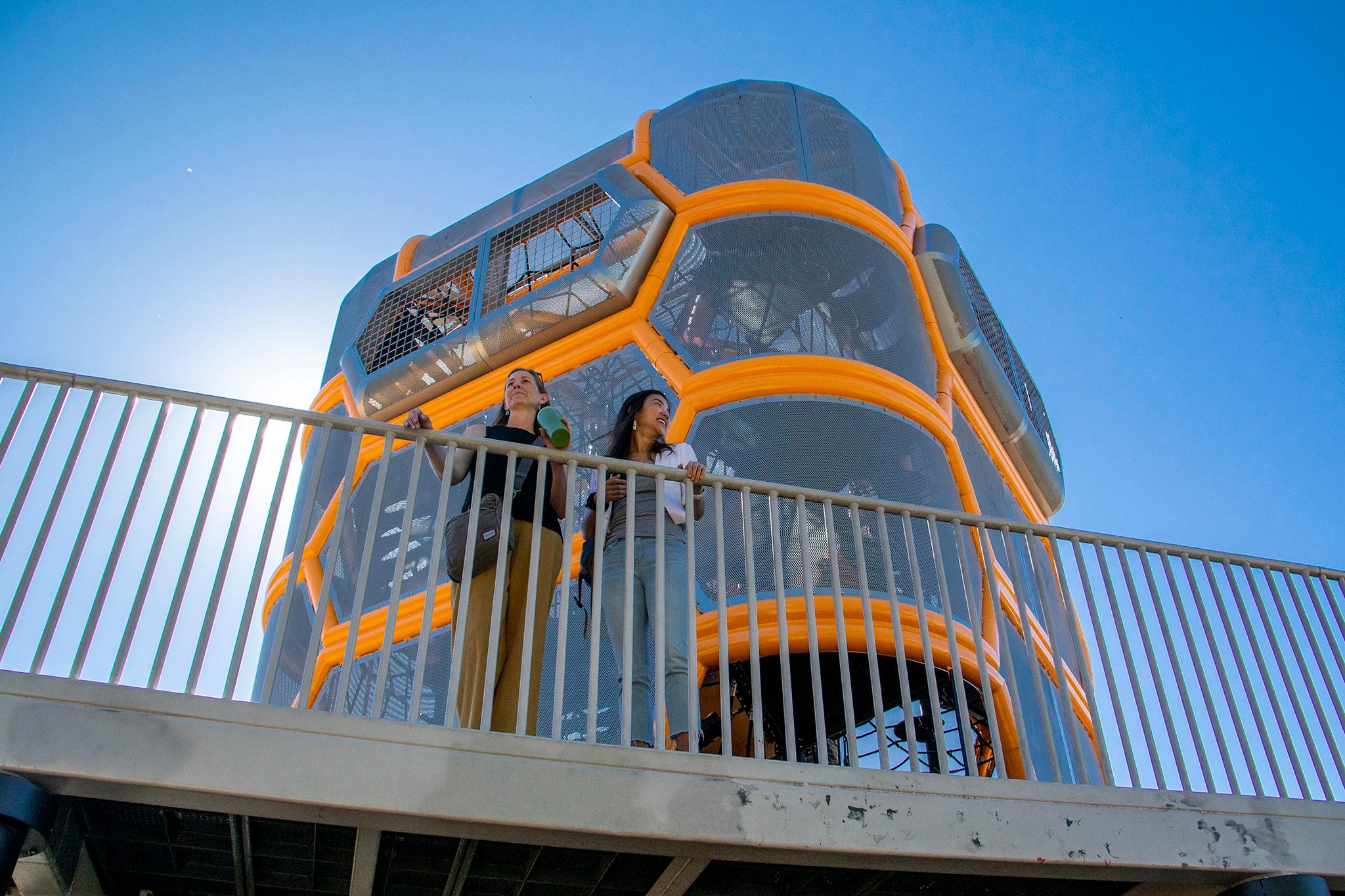
She climbed stairs, ducked under beams, and scrambled up nets past rambunctious kids, while talking about the company that built the tower
"LSI did this fabulous job of designing and manufacturing all of this to work," Raines said. "And one of the things they say that always gets me nervous when we go up a little higher is, 'You can fall.' But they say, 'No one falls like a pencil.'"
The nets would probably help.
On her way up, Raines grilled kids about their experiences at the park. She told one boy that she designed the park. He didn't believe her.
She asked the boy's sister a string of questions: "Do you like this park?" "Is it your favorite park?" "What do you like best about it?" When the girl said her favorite part was climbing, Raines asked about whether she was getting better and trying harder methods. The girl was.
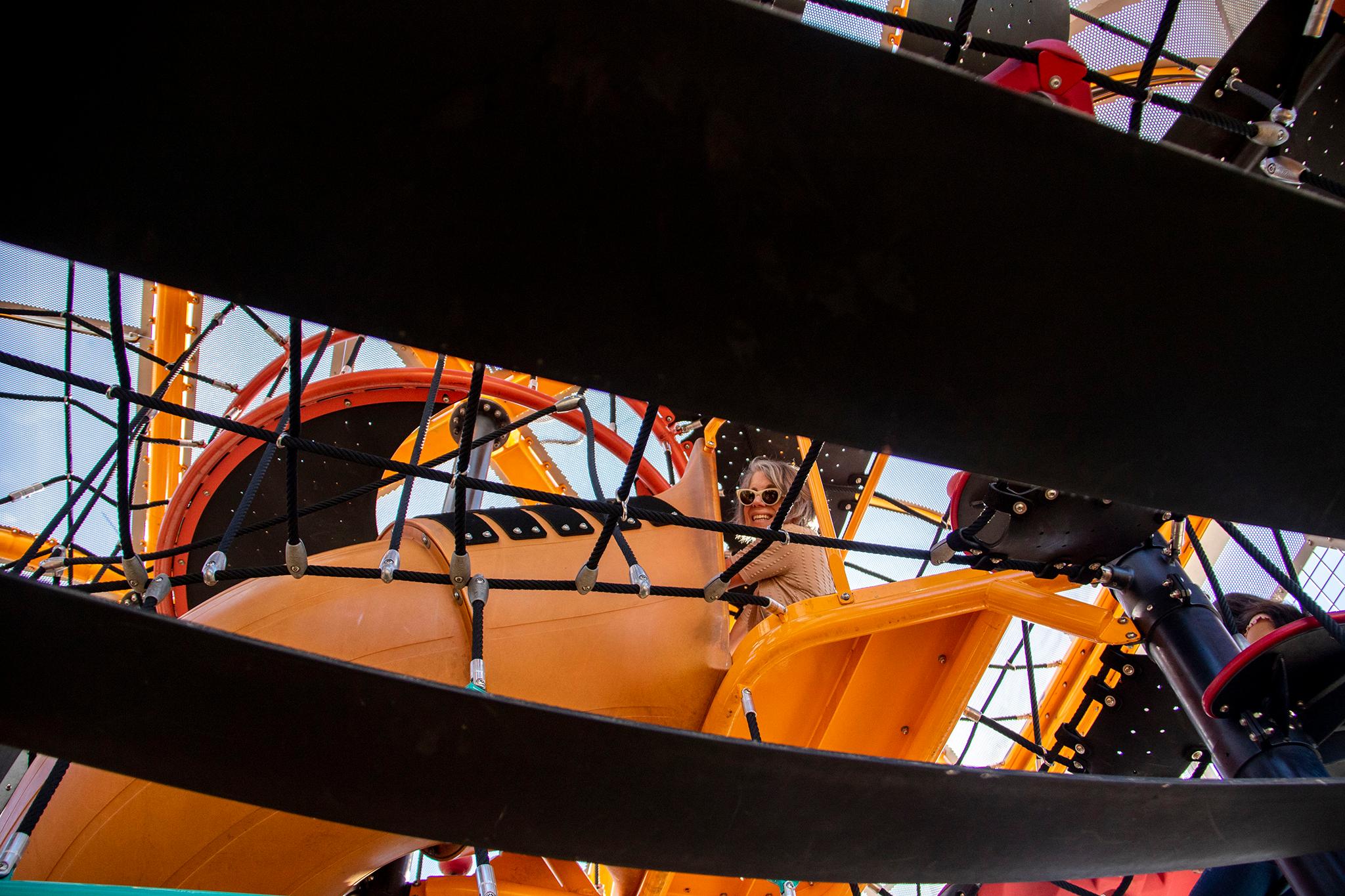
Raines told her she designed the park, and the girl was impressed. The brother confessed he doubted that Raines did so because if she did she'd have a lot of money.
"I did design it," she replied. "I don't know if I made a lot of money, but I did design it."
"Wait, you did design it?" he responded, sufficiently impressed. Raines continued her scramble to the top, before sliding down a long slide that she said was more humid and slower than usual.
Raines takes pride in the park's success, but she's also quick to note problems.
While the native Colorado grasses are flourishing, patches of the should-be-green turf are dry. There aren't enough sprinkler heads installed in the ground. A popular zipline structure is out of commission and may soon be replaced. And graffiti sullies some of the playground equipment, a particular sore spot for Raines.
"If we could just get people not to spray paint," she said. "After such a labor of love, it's hard to watch. But at least people were using it, and that was the idea. And that's what's so rewarding to us that people use it, and really enjoy it."
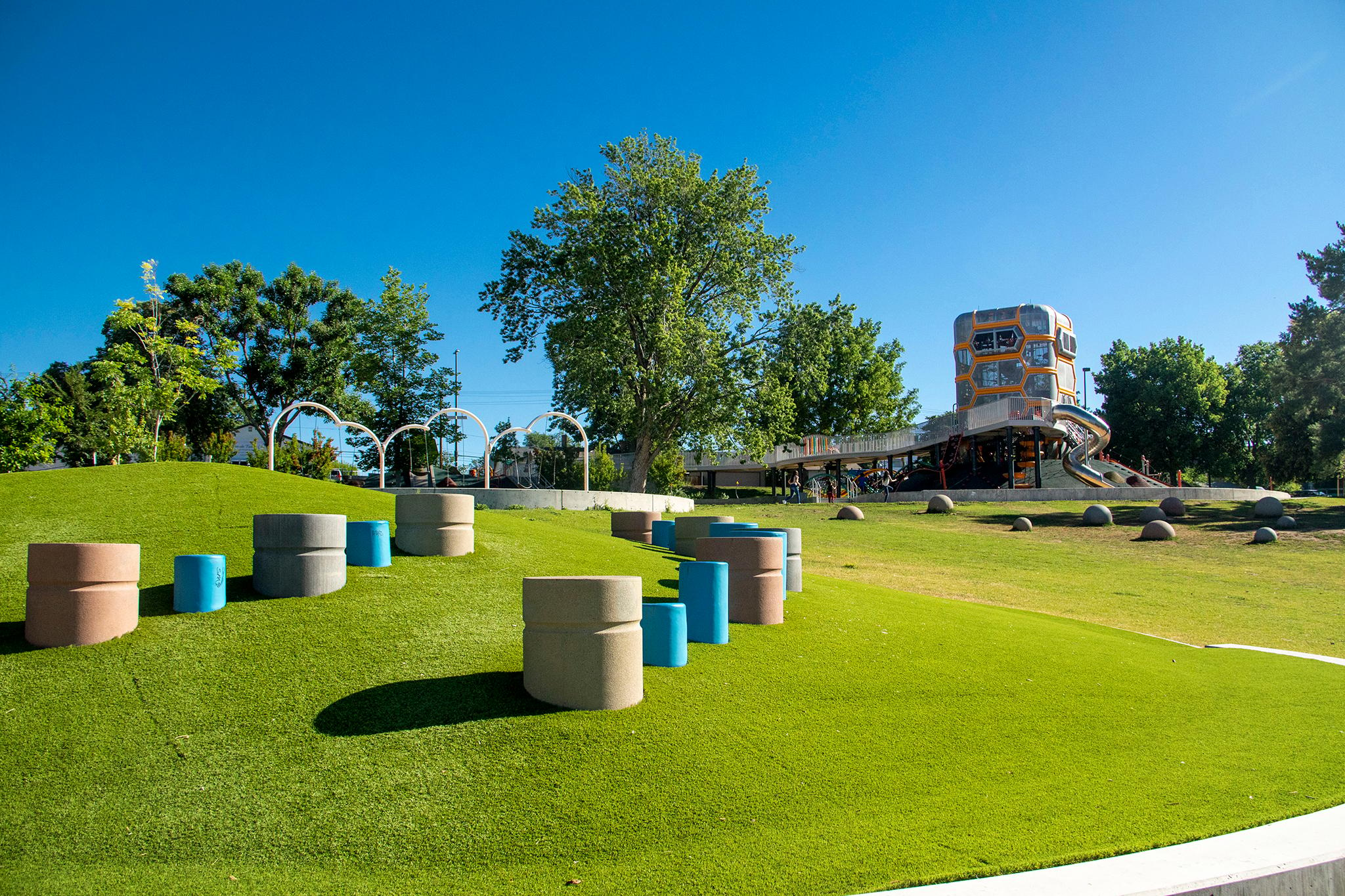
At one point, a group of unhoused people set up camp inside the microphone-shaped tower and were living in it like a treehouse, until they decided to light a campfire and burned some of the equipment. The manufacturer had saved the designs and was able to replace the damaged parts without too much of a headache. Nobody is living there now.
The sound phenomenon wasn't the only happy surprise the designers encountered on Thursday. As the trio of designers left the park, Raines was elated to see a man and woman picking up trash.
"Are you guys volunteering to clean up?" Raines asked.
"We are," said the woman.
"Thank you," Raines said. "We designed this place."
"No kidding," said the man. "Good job. We were just talking about how cool it was."

